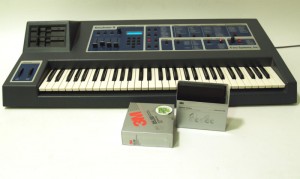I’m a bit obsessed with old samplers, but I’m not really a fan of old hardware. Having owned several hardware samplers, I’m really happy these days with NI Kontakt and Redmatica Autosampler. The old hardware was limited in many ways. The cool thing is though, that a lot of talented people worked hard within those limitations, and got some excellent results. There are some older sounds that you wouldn’t really be inclined to do nowadays with gigabytes of storage. Like this classic string sound: 538kbytes!

So we’ll be looking at the classic sounds from these samplers:
Emu Emulator
Emu Emulator II
Fairlight CMI I, II, IIx (the libraries overlap)
Fairlight CMI III
Casio FZ-1
Ensoniq Mirage
Yamaha TX16W
And a few other things such as the Kawai K1, K4 oh, and the Synclavier!
You might say this has been done before. Well it has, but not quite like this. Libraries like the excellent UVI material are sampled from the machine’s analogue outputs. Mine are different. I’ve looked at various ways of converting the old sounds from the original disks into Kontakt, trying to keep the original multisample positions and mod settings where appropriate. So we’ll start with the Emu Emulator II.
As a sampler, this was really more advanced than the Fairlight II, its only real competitor at the time. The Fairlight was also a sequencer and rudimentary additive synth. The Emu excelled with more memory, proper multisampling, velocity crossfading and an entire analogue synth engine. So it was more of a musical instrument than the Fairlight computer.
Of course, the sound quality was not perfect, so engineers of the day used all sorts of processing to get the thing to sit properly in a mix. Some people like the sound of crappy digital to analogue converters. Not me! But I think you’ll find it interesting how much of the character is encoded in the sampling process, rather than the playback process. Playing back these sounds in a modern sampler brings that sheen that engineers were always trying to get back in the day.
I converted the EII material using EMXP. First converting to SoundFont format (which Emu developed from the EII) and then importing that into Kontakt. The translation is seamless about 50% of the time! Sometimes you end up with strange filter settings and overlapping samples. Luckily, the classic Marcato strings is in the seamless category.
This sound was on the first disk of 5 sounds Emu released with the machine. It’s a big powerful sound even today. There’s a version of it tucked away in the Reason factory library. It’s been used on countless hits, but most notably INXS’s Never Tear us Apart, and the Pet Shop Boys West End Girls.
Here it is for download in WAV and Kontakt format. I’d recommend the free Kontakt player so you get the samples all set up correctly ready to play as they would been on a real EII.
Update: for those of you using the WAVs, here is a text file with the loop points, tuning, mapping and VCA info.

which is which? A sounds like it has a stgonrer midrange and more present and B has like a sunk in sound to it. like sunk in the mid range. so my guess would be A is the EII because i am guessing that kontakt would not add frequencies i would think kontakt would be more plain and more tamed so i would think it wouldn’t add mid range and presence im listening with headphones though so it’s hard to hear. i’ll check it out later at the studio so which is which!? super cool post by the way! THANX
Thank you very much ! It sounds perfect.
Are you planning to upload all the Emulator II samples
like you did with the Fairlight ?
Wow, thank you so very much!
I’ve been looking for the strings sound on Deep Purples Perfect Strangers album (like the intro on Knocking at your back door) for ages. Recently I watched a clip from a live show in 1985 and could see that Jon Lord used a Emulator II. And after a quick search on Google I ended up here, dowloaded the files and imported them in Kontakt. Wow, it’s THE sound! 🙂
It’s always good to find the right sound. You’re welcome!